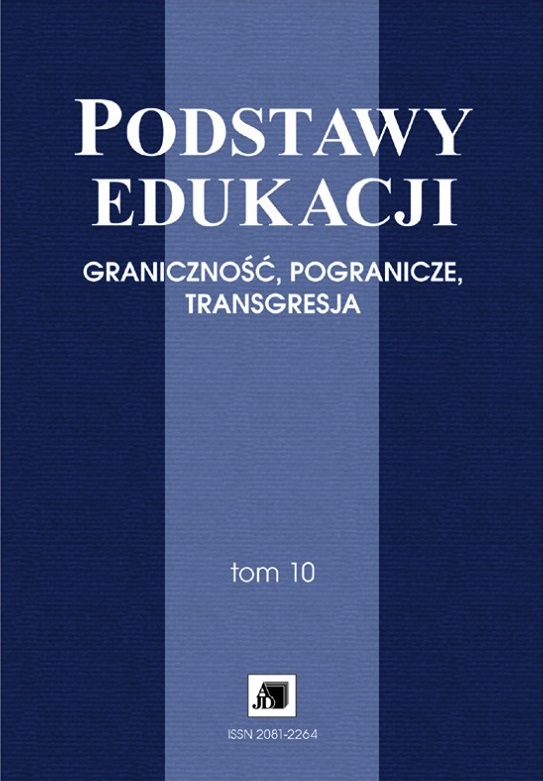Abstract
The present article analyses issue of tulku or people regarded as reincarnations of Tibetan masters. It shows meaning of the tulkus in Tibetan Buddhism, and character of traditional education of monks (all tulkus have to be monks during their school years). The main concern of the author is criticism of tulku educational system, both in Tibet and outside it. What was already mentioned by other authors (corruption, violence against young tulkus) in feudal Tibet is reproduced in Tibetan monasteries outside Tibet. Some young tulkus, especially those who have been recognized in the West, do not accept tulku system. Few of them quitted monkhood, and some even rejected Buddhism.
References
A new dawn of tulkus (2012). http://www.dorjeshugden.com/forum/index.php? topic=2389.5;wap2 [dostęp: 29.04.2016].
A Day in the Life of a Monk (b.d.). http://tibetansponsorship.org/sera-jeymonastry/a-day-in-the-life-of-a-monk [dostęp: 17.05.2017].
Ary, E. (2013). The Westernization of Tulkus. W: V.R. Sasson (red.), Little Buddhas: Children and Childhoods in Buddhist Texts and Traditions. Oxford: Oxford University Press, 398–427.
Barlocher, D. (1982). Testimonies of Tibetan Tulkus: A Research among Reincarnate Buddhist Masters in Exile, 1, Rikon/Zurich.
Bishop, P. (1989). The Myth of Shangri-La: Tibet, Travel Writing and the Western Creation of Sacred Landscape. London: Athlone Press.
Bloch, N. (2011). Urodzeni uchodźcy: Tożsamość pokolenia młodych Tybetańczyków w Indiach. Wrocław: Wydawnictwo Uniwersytetu Wrocławskiego.
Butrymowicz, S. (b.d.). A day in the life of Chinese students. http://hechingered.org/content/a-day-in-the-life-of-chinese-students_3826 [dostęp: 21.08.2017].
Campbell, J. (1996). Traveller in Space: In Search of Female Identity in Tibetan Buddhism. New York: George Braziller.
Chögyam Trungpa (1983). First Thought Best Thought: 108 Poems. Boulder: Shambala.
Chögyam Trungpa (2003). Journey Without Goal. W: tegoż, Collected Works. 4. Boston: Shambala, 1–135.
Chögyam Trungpa Rinpocze (2016). Urodzony w Tybecie. Poznań: Dom Wydawniczy Rebis.
Choseng Trungpa (b.d.). https://en.wikipedia.org/wiki/Choseng_Trungpa [dostęp: 18.06.2016].
Chua, A. (2011). Bojowa pieśń tygrysicy. Prószyński i S-ka: Warszawa.
Dalajlama (1993). Wolność na wygnaniu: Autobiografia jego świątobliwości Dalajlamy Tybetu. Warszawa: Wydawnictwo Atlantis.
Datta, K. (2000). Reincarnation and Politics in Tibet. Bulletin of Tibetology, New Series. 1–3, 1–13.
Dreyfus, G.B.J. (2003). The Sound of Two Hands Clapping: The Education of a Tibetan Buddhist Monk. Berkeley: University of California Press [epub].
Dzongsar Jamyang Khyentse Rinpoche (2016). Time for Radical Change in How We Raise Our Tulkus. Tricycle. 22.08.2016, https://tricycle.org/ trikedaily/time-for-radical-change-in-how-we-raise-our-tulkus [dostęp: 30.04. 2017].
Etesami, R. (b.d.). Tulku System in Tibetan Buddhism: Its Reliability, Orthodoxy and Social Impacts. M.A. Thesis, International Buddhist College, Thailand.
Falk, G.D. (2009). Stripping the Gurus: Sex, Violence, Abuse, and Enlightenment. Toronto: Million Monkeys Press.
Gyatso, J. (1998). Apparitions of the Self: The Secret Autobiographies of a Tibetan Visionary. Princeton: Princeton University Press.
Hooper, J. (2012). Blowing the Whistel on Sexual Abuse at Buddhist Monasteries. Des Tibetischen Buddhismus. http://www.lamatruth.com/ying/?type =detail&id=225 [dostęp: 20.02.2017].
Kapstein, M.T. (2010). Tybetańczycy. Kraków: Wydawnictwo Uniwersytetu Jagiellońskiego.
Kawaguchi, E. (1909). Three Years in Tibet. Adyar: Vedanta Press.
Laird, T. (2008). Opowieść o Tybecie: Rozmowy z Dalajlamą. Poznań: Dom Wydawniczy Rebis.
Landon, P. (1905). Lhasa: An account of the country and people of Central Tibet and of the Progress of the mission sent there by the English Government in the year 1903–4. London: Hurst and Blackett.
Mackenzie, V. (1989). Reincarnation: The Boy Lama. London: Bloomsbury Publications.
Mackenzie, V. (1995). Reborn in the West: The Reincarnation Masters. London: Bloomsbury Publications.
Maraini, F. (1993). Secret Tibet. Delhi: Book Faith India.
Martin, M. (2003). Music in the Sky: The Life, Art, and Teachings of the 17th Gyalwa Karmapa Ogyen Trinley Dorje. Ithaca: Snow Lion Publications.
Mukpo, D.J. (2008). Dragon Thunder: My Life with Chögyam Trungpa. Boston: Shambala.
Mullin, G. (2008). Czternastu Dalajlamów: Spadkobiercy oświeconej mądrości. Warszawa: Agencja Wydawnicza Jacek Santorski & Co.
Namkhai Norbu (1991). Istota dzogczen. W: tegoż, Rób to na co masz ochotę. Kraków: Wydawnictwo Miniatura, 27–43.
Namkhai Norbu (2001). Kryształ i ścieżka światła: Sutra, tantra i dzogczen. Kraków: Wydawnictwo „A”.
Ngałang Zangpo (H.L. Thompson) (2002). Rozpoznawanie inkarnowanych mistrzów. W: Dziamgon Kongtrul Lodro Thaje. Intronizacja: Odnajdywanie inkarnowanych mistrzów Tybetu i Himalajów. Kraków: Wydawnictwo Mudra, 67–71.
Osel Hita Torres – The Reluctant Lama (2012). BBC News, 28.09.2012. http://www.bbc.com/news/magazine-19702122 [dostęp: 29.04.2016].
Pallis, M. (1946). Peaks and Lamas. London: Cassell and Company.
Ravidas, R., Mangar, N. (2016). Renunciation on FB – Not a monk any more, says post. The Telegraph. August 12. https://www.telegraphindia.com/ 1160812/jsp/frontpage/story_102067.jsp [dostęp: 26.06.2017].
Ray, R. (1986). Some Aspects of the Tulku Tradition in Tibet. Tibet Journal, 11:4, 35–69.
Sieradzan, J. (2007). Koncepcja umysłu w buddyzmie. Idea: Studia nad Strukturą i Rozwojem Pojęć Filozoficznych, 19, 13–32.
Sieradzan, J. (2005). Szaleństwo w religiach świata: Szamanizm, religia starogrecka, judaizm, chrześcijaństwo, hinduizm, buddyzm, islam. Kraków: Inter Esse, Wydawnictwo Wanda.
Sieradzan, J. (2018). Zmotoryzowani tulku: Zachodnie reinkarnacje tybetańskich buddystów. Warszawa: Wydawnictwo Psychologii i Kultury Eneteia.
Tenzin Gyatso, 14th Dalai Lama of Tibet (2011). Reincarnation. http://www. dalailama.com/messages/statement-of-his-holiness-the-fourteenth-dalailama-tenzin-gyatso-on-the-issue-of-his-reincarnation [dostęp: 22.05.2016].
Thondup, T. (2011). Incarnation: The History and Mysticism of the Tulku Tradition of Tibet. Boston: Shambala [epub].
Thondup Rinpocze, T. (1998). Ukryte nauki Tybetu: Wyjaśnienie dotyczące tradycji term w buddyjskiej szkole Ningma. Warszawa: Wydawnictwo Mandala.
Tworkhov, H. (1996). The Emperor’s Tantric Robes: An Interview with June Campbell on Codes of Secrecy and Silence. Tricycle. Winter. http://www. anandainfo.com/tantric_robes.html [dostęp: 11.06.2016].
Wilde-Blavatsky, A. (2013). What Lies Beneath the Robes: Are Buddhist Monasteries Suitable Places for Children? Elephant Journal, 7.06.2013, http://www.elephantjournal.com/2013/06/what-lies-beneath-the-robes-are-buddhist-monasteries-suitable-places-for-children-adele-wilde-blavatsky [dostęp: 11.06.2016].
Filmografia
My Reincarnation (2011). Reżyseria Jennifer Fox.
Tulku (2009). Reżyseria Gesar Mukpo, Kanada.
I am aware that the journal is published under the Creative Commons Attribution License (https://creativecommons.org/licenses/by/4.0/legalcode).
By submitting an article, I agree to make it available under this license.
